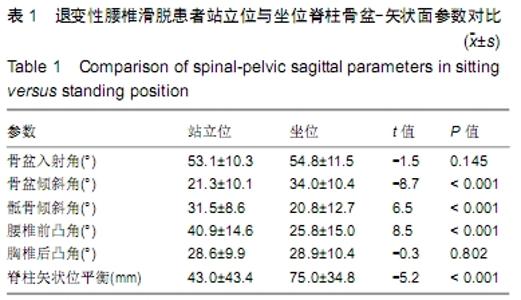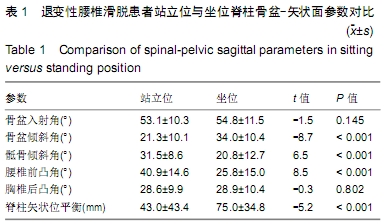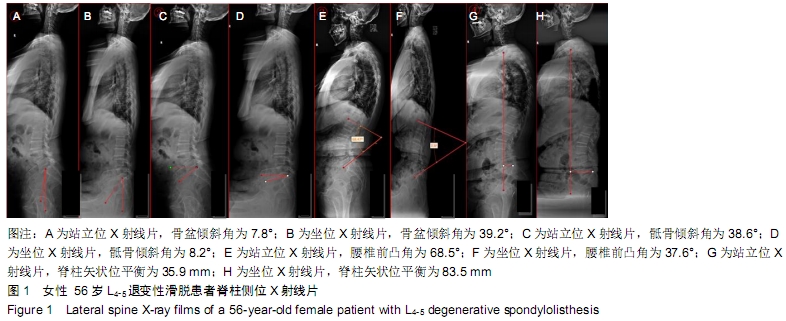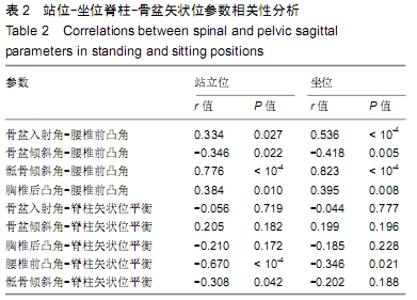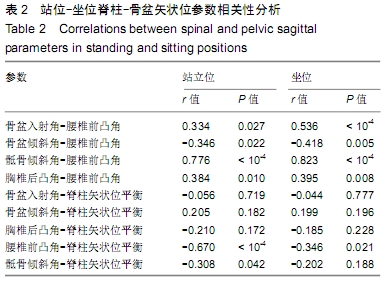[1] LAZENNEC JY, FOLINAIS D, BENDAYA S, et al. The global alignment in patients with lumbar spinal stenosis: our experience using the EOS full-body images.Eur J Orthop Surg Traumatol.2016;26(7):713-724.
[2] MATSUMOTO T, OKUDA S, MAENO T, et al. Spinopelvic sagittal imbalance as a risk factor for adjacent-segment disease after single-segment posterior lumbar interbody fusion.J Neurosurg Spine.2017;26(4):435-440.
[3] SUN Y, WANG H, YANG D, et al. Characterizatjon of radiographic features of consecutive lumbar spondylolislhesis. Medicine.2016;95(46):e5323.
[4] WANG T, WANG H, IIU H, et al. Sagittal spinopelvic parameters in 2-level lumbar degenerative spondylolisthesis: a retrospective study.Medicine.2016;95(50):e5417.
[5] BARRETT E, LENEHAN B, KIERAN O’SULLIVAN, et al. Validation of the manual inclinometer and flexicurve for the measurement of thoracic kyphosis. Physiother Theory Pract, 2018;34(4):301-308.
[6] SULTAN AA, KHLOPAS A, PIUZZI NS, et al. The Impact of Spino-Pelvic Alignment on Total Hip Arthroplasty Outcomes: A Critical Analysis of Current Evidence.J Arthroplasty.2018; 33(5):1606-1616.
[7] MAC-THIONG JM, PARENT S, JONCAS J, et al. The importance of proximal femoral angle on sagittal balance and quality of life in children and adolescents with high-grade lumbosacral spondylolisthesis.Eur Spine J. 2018;27(8): 2038-2043.
[8] HIDEKAZU S, KENJI E, YASUNOBU S, et al. Radiographic Assessment of Spinopelvic Sagittal Alignment from Sitting to Standing Position.Spine Surg Relat Res.2018;2(4):290-293.
[9] MERCHANT G, BUELNA C, CASTANEDA SF, et al. Accelerometer measured sedentary time among Hispanic adults: Results from the Hispanic Community Health Study/Study of Latinos (HCHS/SOL).Prev Med Rep. 2015;2: 845-853.
[10] RINGHEIM I, INDAHL A, ROELEVELD K. Reduced muscle activity variability in lumbar extensor muscles during sustained sitting in individuals with chronic low back pain. PLoS One. 2019;14(3):e0213778.
[11] CHEVILLOTTE T, COUDERT P, CAWLEY D, et al. Influence of posture on relationships between pelvic parameters and lumbar lordosis: Comparison of the standing, seated, and supine positions. A preliminary study.Orthop Traumatol Surg Res.2018;104(5):565-568.
[12] 孙卓然,姜帅,邹达,等.国人青年人群坐-立位脊柱-骨盆矢状位序列变化研究[J].中国脊柱脊髓杂志,2018,28(4):44-48.
[13] 王伟,周思宇,孙卓然,等.中老年人从站立位到坐位的脊柱矢状位序列变化[J].中国脊柱脊髓杂志,2019,29(7):621-626.
[14] 袁倚文,刘臻,胡宗杉,等.选择性融合对Lenke 1型青少年特发性脊柱侧凸患者站立和坐位腰椎与骨盆矢状面平衡的影响[J].中国脊柱脊髓杂志,2019,29(1):1-8.
[15] OBA H, EBATA S, TAKAHASHI J, et al. Loss of Pelvic Incidence Correction After Long Fusion Using Iliac Screws for Adult Spinal Deformity: Cause and Effect on Clinical Outcome. Spine (Phila Pa 1976).2019;44(3):195-202.
[16] RADOVANOVIC I, URQUHART JC, GANAPATHY V, et al. Influence of postoperative sagittal balance and spinopelvic parameters on the outcome of patients surgically treated for degenerative lumbar spondylolisthesis.J Neurosurg Spine. 2017;26(4):448-453.
|
